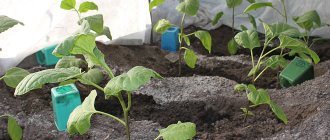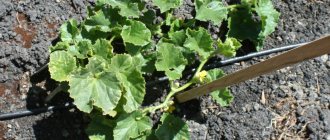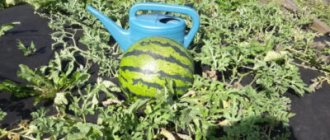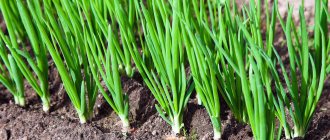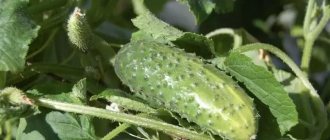How to water eggplants correctly? To answer this question, you need to learn more about what irrigation methods exist and what are the characteristics of soil moisture at different stages of the growing season. You will learn about this, as well as the requirements for the frequency of watering and ways to make the procedure even more beneficial for plants, while reading this article.
How often to water eggplants?
Eggplants do not need too frequent irrigation, as this can lead to changes in the soil structure and the appearance of fungus.
Regularity depends on weather conditions:
- Heat. Repeat the procedure at least once every 3 days.
- Rains. As the earth dries out.
- Neutral climate. You need to add liquid once a week.
There should be about 2 liters of water per plant.
Watering methods
There are 3 main methods of watering. Each of them has its own advantages and disadvantages.
Using a watering can
It involves manually irrigating plants using a container that usually holds about 10 liters of water. This amount of liquid is enough for 1 square. m of plantings.
What you need to know:
- Plus. Allows you to combine watering with fertilizing. To do this, water is mixed with fertilizers.
- Minus. You have to put in more effort and it takes more time.
It is better to remove the nozzle from the watering can.
Watering with a hose
System requirements:
- Temperature control. Water from an artesian well may be too cold, so it should be discarded.
- Pressure Should be small so as not to damage fragile plants.
- Nozzle. It is better to purchase a sprayer with small holes.
- Way. You cannot direct the flow of liquid to the plants themselves; it is better to take care of irrigating the root zone.
Peculiarities:
- Advantage. Save time, cover a larger area.
- Flaw. The hose may damage the plants. It is recommended to stick glass bottles along the edge of the area, which will serve as limiters.
Drip irrigation system
To do this, you will have to purchase a special tape with holes for water supply. With their help, the liquid reaches directly to the roots of the plants, moistening the soil at a distance of 50 cm and to a depth of 30 cm. The system should be laid between 2 rows of eggplants.
What to pay attention to:
- On a positive note. Watering is virtually effortless. Plants receive moisture at the same frequency and in equal quantities.
- Negative side. Financial investments will be required. But such an installation, if used carefully, can last 4-5 seasons.
Watering at different stages of the growing season
Each stage of growth has its own characteristics of soil moisture. It is important to pay attention to them so as not to destroy the plants.
First shoots
Among the main requirements:
- Way. It is carried out at the root of the sprout. In this case, you need to take care of the dryness of the stems and leaves.
- Volume. It is necessary to slightly moisten the soil. Large amounts of liquid can lead to the development of fungal diseases.
- Tools. A watering can is used. With its help, the seedlings are watered very carefully. It is important to prevent damage to plants.
Using glass or transparent film to cover the seedlings will help reduce the need for liquid. It needs to be moved slightly 2 times a day to ensure the flow of oxygen.
After planting the seedlings in a permanent place
Before carrying out the procedure, the beds must be thoroughly moistened. Then watering is carried out regularly until the eggplants take root completely. At this time, the soil should not be allowed to dry out. About 3 liters of water are applied to 1 bush.
Flowering phase
Among the recommendations:
- Temperature. Should be close to the soil in the garden bed.
- Caution. Avoid getting liquid on the ovaries and flowers so that they do not fall off.
- Quantity. Plants require approximately 4-5 liters of water.
Period of fruit formation and growth
To get a good harvest, you need to follow the recommendations:
- Irrigate only in the morning;
- the liquid should moisten the soil to a depth of about 25 cm;
- take care of the correct water temperature;
- apply 4-5 liters per bush.
Disease and pest control
During growth, eggplants can contract a whole “bouquet” of various diseases. The most harmful diseases are: root rot, tracheomycosis, root rot, stolbur and leaf mosaic.
This crop is often infected with fungal and viral diseases, as well as bacterial rot. Disease control involves prevention and treatment of plants and soil with special preparations:
- Biochemical . They are not harmful to plants, animals and humans. They are also safe for beneficial insects such as bees.
- Chemical . They quickly cope with the cause of the disease, but they are harmful to humans and affect the quality of products. Chemical residues accumulate in the fruits.
How to water eggplants correctly?
There are several features of watering this crop:
- Right time. Do not add water during the middle of the day when the sun is shining brightly. As moisture evaporates, the risk of wilting increases. The best period is from morning to lunch, when the heat is not yet so strong.
- Do not wet the leaves. When water gets on the surface of greenery, the risk of developing fungal diseases increases. Therefore, the sprinkling method should be excluded.
- Creating grooves. Make small grooves around the bush, into which you then add water. This has a positive effect on liquid absorption.
You can learn about the main features of proper watering of eggplants while watching the presented video:
There are also differences in watering requirements in different conditions.
In the greenhouse
What information should you learn:
- Way. The drip irrigation method is predominantly used.
- Time. You can add water in the morning or late in the evening.
- Frequency. Selected individually. Usually the same as with standard watering. But if the leaves begin to dry, you should increase the frequency.
- Temperature. It is better to take liquid that has settled for 1-2 days in a greenhouse.
- Humidity. You should avoid high humidity in the room, as this negatively affects the health of the plants. Need to ventilate more often.
In the open ground
The frequency and volume of watering depend on weather conditions. Both soil waterlogging and drying out should not be allowed. Young plants are watered approximately once every 7 days. During the flowering phase, the moisture supply is slightly reduced and increased during fruit ripening.
Preparing the greenhouse for planting
The greenhouse shelter must be completely ready for transplanting seedlings. Its preparation begins in the fall. In all recommendations on how to grow eggplants in a greenhouse made of polycarbonate or other material, it is advised to remove everything from the greenhouse after harvesting. There should be no pegs, benches or other furniture, water barrels, boards or even textile ties left inside the room. All of these are excellent shelters for overwintering pest larvae and pathogenic microflora. Autumn cleaning of the greenhouse will not give them a chance to survive the winter.
In the spring, they begin to disinfect the shelter. To begin with, all surfaces, including the ceiling and walls, are thoroughly washed with laundry soap. If there were outbreaks of infectious diseases last year, disinfection is carried out with a chlorine solution or a steam generator.
In rare cases, the room is disinfected with a sulfur bomb. This is a very effective product, but its use damages the metal parts of the structure. A checker is used if a spider mite is noticed; crops with the same diseases and pests have been grown for several seasons, if insecticides no longer help. Processing is carried out strictly according to the instructions that come with the checker.
When soil is contaminated with pathogenic microflora and to prevent this problem, disinfection is used. They carry it out in different ways. Let's list the simplest methods.
- Heat treatment. The soil mixture is poured with boiling water, hermetically sealed with film, and left for a day.
- Watering with special means. For treatment, biological products such as “Fitosporin” and fungicidal agents such as “Aktara” are used. You can take a 1% aqueous solution of copper sulfate or potassium permanganate.
- Freezing. In autumn, the top soil layer, about 0.3 m high, is removed. The cut soil is placed in small bags and taken outside. In the spring, the substrate disinfected over the winter is poured back into place.
Before planting young plants, the soil mixture in the greenhouse is dug up. For each square meter of digging, add half a bucket of peat, 1 tbsp. spoons of potassium sulfate and 250 g of ash. Heavy clay soils are additionally loosened with sand or humus.
Special watering and fertilizing
There are several recipes that will help moisten the beds and give vegetables the necessary nutrients:
A solution of ammonia. How to cook:
- Take 3 tbsp. l. alcohol
- Pour in 10 liters of water.
- Pour 2-3 liters under the root of each plant.
Tea infusion. Instructions:
- Take a glass of used leaf tea.
- Pour in 5 liters of hot water.
- Leave for 1-2 days.
- Strain.
- Use for root watering.
Herbal feeding. What do you need:
- Collect plantain, wood lice, nettle, dandelion and other herbs.
- Grind thoroughly.
- Fill 1 kg of grass with 10 liters of water.
- Leave for a week until the fermentation process begins.
- Strain.
- Use 500 ml for each bush.
Potassium nitrate. Preparation method:
- Take 30 g of saltpeter.
- Add 10 g of superphosphate.
- Pour in 10 liters of water.
- Mix thoroughly.
- Use 2-3 liters for each plant.
This recipe helps strengthen eggplants and save them from wilting.
Eggshell infusion. The steps are as follows:
- Take shells from 10 eggs.
- Grind thoroughly.
- Pour in 5 liters of heated water.
- Leave for 2 days.
- Strain.
- Pour 1-2 liters per bush.
Water contains calcium, which is necessary for the growth and strengthening of plants.
Formation of bushes
I achieve this result primarily thanks to proper care, timely watering and regular fertilizing. An important point in caring for eggplants is the mandatory formation of the bush.
Many gardeners, as they say, do not bother with shaping eggplants, but I have learned from my own experience that by shaping the bushes correctly, you can get larger fruits. In addition, the bushes grow strong and produce a large harvest.
- Aphids on cucumbers are not a death sentence: 3 simple ways to fight without chemicals
Stepsoning
By shaping bushes I mean pinching, that is, removing excess shoots. Regardless of the height of the variety, I always cut off the stepsons that grow below the fork: at first the eggplant seedlings grow in one stem, but over time the seedling forms a branch into two stems, and until this moment, as the bush grows, I remove the stepsons in each leaf axil. This technique allows you to relieve the bush at an early stage of growth and give it the opportunity to get stronger by the time of flowering.
Removing a bud
The first bud on eggplants, like on peppers, is usually located in the center of the fork. This first flower is called the crown flower. If the bushes have not yet grown and become strong enough, I pinch off the crown flower, but if the bush is strong, developed and is able to feed the first fruit without compromising its growth and the setting of subsequent fruits, the bud can be left.
Removing the lower leaves
After I have formed the bushes up to the first fork, I stop removing those stepsons that grow above the fork, but I continue to free the lower part from shoots.
When the first fruits set on the eggplants, I begin to gradually remove the leaves located on the trunk below the fork, and first of all those that touch the ground. This should not be done at once, but approximately one or two sheets every 5-7 days. This technique improves the ventilation of the eggplant bed and reduces the likelihood of the bushes becoming infected with fungal diseases and pests.
How to reduce plants' need for moisture?
There are several secrets that will help reduce the frequency of irrigation:
- Soil selection. It is best to grow eggplants in loose, sandy soils. This will help increase drought tolerance.
- Use of fertilizers. If, after planting, you dig a small ditch around the bush, pour fertilizer into it, and then fill it with water, this will have a positive effect on the development of vegetables and will help retain moisture longer.
- Mulching. The row spacing should be mulched with sawdust or eggshells.
Watering eggplants is not particularly difficult. The main thing is to choose the right method, remember the requirements for water and the frequency of moistening, and use the instructions. Special recipes will help make plants even healthier and stronger. This is the only way to get a really good harvest.
0
0
Copy link
Growing seedlings
The cultivation itself consists of several stages. Let's look at each of them.
Seed selection and preparation
In order for the harvest to please the eye, first of all, prepare the seeds. If the seeds were purchased in a specialized supermarket or store, carefully read the instructions on the package. It is quite possible that the manufacturer was worried about preparing the seed material. And you no longer need to do anything with them until sowing.
If you are not 100% sure, it is necessary to carry out a series of calibration and disinfection measures.
Eggplant seeds need to be calibrated
Seed calibration
Since eggplant seeds are quite large, it will not be difficult for you to select them by size. Discard small and damaged seeds. Also discard misshapen seeds.
To check the completion, take half a liter of warm water and dissolve one tablespoon of table salt in it. Pour the calibrated seeds into the resulting solution. Seeds that float to the surface of the solution must be removed. The seeds that have fallen to the bottom are washed with running water and dried. This is an excellent seed material.
Disinfection of seed material
Prepare a solution of potassium permanganate (potassium permanganate). Take seven to ten crystals for half a liter of water. Place eggplant seeds in the resulting solution for twenty to thirty minutes. This procedure will prevent a number of soil and fungal diseases.
Use biostimulants
In order to fill the seeds with microelements that will speed up the germination process, follow these steps. According to the instructions on the package, soak the seeds in a solution of Zircon or Epin. These drugs can be purchased at any garden store.
Germination of seeds
To speed up seed germination, it is necessary to germinate them. To do this, use cotton pads. Place eggplant seeds between two wet sponges and place in a warm place. As soon as the length of the sprouts reaches three to four millimeters, the seeds can be planted.
